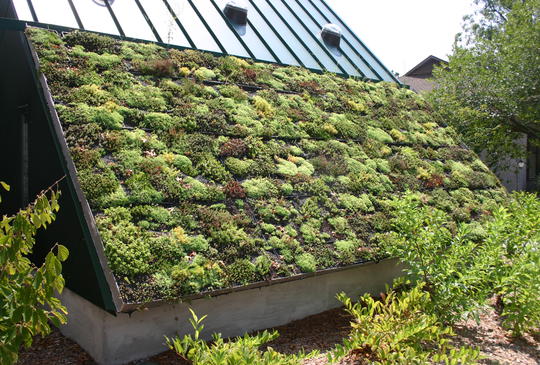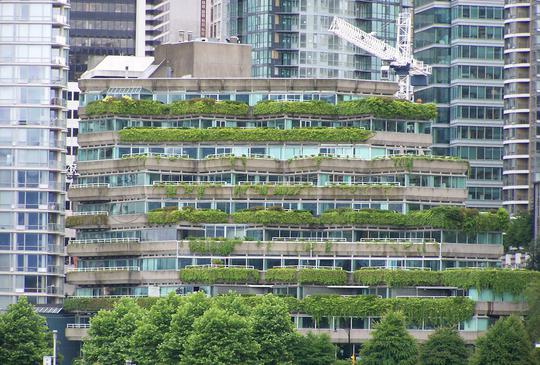
Why Do We Need Green Roofs?
Contributed by Sam Hartley
Other ways to describe green roofs: Living roof, eco-roof, roof garden, earth-sheltered structure, brown roofs, green-blue roofs, biodiverse roofs, vegetated roof cover, green cloak
The value green roofs can bring to a building go far beyond they joys of a pleasant rooftop café. Green roofs can not only benefit those who own or use the building but also the wider urban environment and local communities around them.

Far from being a modern invention, the origins of green roofs began thousands of years ago where moss and grass were utilised to cool houses in the summer and warm them in the winter. The most notable historic green roof is the Hanging Gardens of Babylon near present day Iraq. Constructed in 500 BCE, it was considered one of the seven wonders of the ancient world. More recently, Scandinavian homes use a traditional green roof method to provide insulation and protection from harsh conditions.

The value of this nature-based solution has been understood across history, and our recent research shows that the benefits they can bring are needed now more than ever.
How do we know the benefits?
While more green space is widely perceived as beneficial, the IGNITION project wanted to drill down into the detail of who these benefits effect and how and why they’re so powerful. As part of the project, research was undertaken by project partners GMCA and BITC to review available evidence on the benefits of nature-based solutions. These solutions included green roofs, green walls, street trees, sustainable urban drainage systems, urban parks and green spaces. This evidence was then compiled in a database that will soon be available to the general public. Over six months, the project reviewed:
- 1000+ evidence items
- Across 5 urban nature-based solutions
- Measuring 12 benefits across social, environmental and financial areas; such as health and local economic growth

This evidence base, available to download alongside supporting resources here, will remain a live repository of information, updating with new studies when they become available. Watch our ‘How to use the evidence base’ webinar here.
There are 256 evidence items within the evidence base for green roofs.
What did we find?
Green roofs can provide financial savings for developers, owners and occupants by:
- The insulating effect of green roof can reduce energy consumption for heating by 3.6%
- Increasing roof insulation value by 25% compared to a conventional roof
- Reducing energy demand for cooling by, on average, 16% through greater insulation
- Reducing total annual energy demand for spaces directly below the roof by 6.7%
- Extending roof life by on average 23 years over a conventional roof, by protecting the surface from the elements
- Reducing surface temperature by up to 14.5°C, resulting in reducing internal cooling costs from air conditioning
- Increasing property value by around 3-7%
- Providing a unique outdoor social or hospitality space
Green roofs can help us adapt to the effects of climate change by:
- Managing and storing rainfall on-site by retaining on average 62% rainwater runoff and reducing pressure on water systems.
- Delaying peak runoff from storms by 73% and helping to limit flooding
- Helping to cool the air by aroun 1°C. This is particularly useful in times of increased heat waves, where the density of hard surfaces in our cities increases the local temperature (known as Urban Heat Island effect)
- Helping to store an average 0.4kg of carbon per m² and soak up 1.3kg of carbon per m² per year
Green roofs can help restore our natural environment by:
- Restoring habitat for biodiversity. In one study of 17 green roofs in Basel, Switzerland, 78 species of spider and 254 beetle species were identified during the first three years of observation. 18% of those spiders and 11% of the beetles were listed as endangered or rare.
- Improving air quality by filtration from the green roof planting. Some studies show reductions in two common pollutants with a 24% reduction in nitrogen dioxide and a 22% reduction in sulphur dioxide surrounding a green roof
- Allowing for green space in urban environments where parks and green spaces have been removed
The design of green roofs can range from a thin layer of growing medium to large, deep gardens hosting a diversity of plants. Different roof types provide benefits to a greater or lesser extent, but all provide more functionality than a conventional roof. Keep an eye out for the IGNITION nature-based solutions living lab at the University of Salford, that will host various green roofs along with other interconnecting nature-based solutions, whilst monitoring and researching their performance on key areas.
Green roofs have the potential to transform how the built environment looks, functions and feels. As 85% of the buildings that will be in use in 2050 already exist today, green roofs provide the much-needed surface area to help us harness nature to adapt to climate change, restore our natural environment and improve energy and resource efficiency.

Getting the Green Light – How Do Nature-Based Solutions Perform?
Contributed by Sam Hartley
Developing the Nature-Based Solutions Living Lab at Salford University
Contributed by Jennifer Lane
Contributor Profile
Sam Hartley is Campaign Officer for the Business in the Community Environment team, working full time of the IGNITION Project. She joined the project in October 2019, moving from working on environmental projects in Scotland. Along with GMCA, Sam has led on the research for the nature-based solutions Evidence Base for the IGNITION project.




